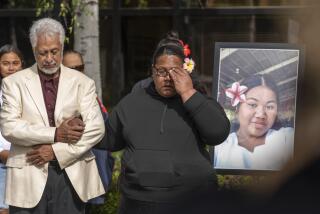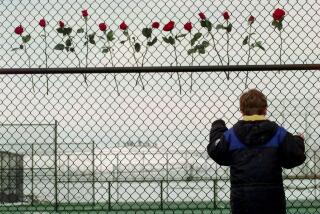Leaders of mass-murder sites share pain, support
- Share via
AURORA, Colo. — It was only a few hours into a day that already felt like it would never end. On July 20, Mayor Steve Hogan suddenly was presiding over a city that had become the home of one of the country’s worst mass shootings.
Looking out his office window at Aurora City Hall, he could see the cheerful pink neon sign of the Century 16 movie theater sparkling in the sun. That morning there were still so many unanswered questions, so many people still unaccounted for after a gunman burst into a midnight showing of “The Dark Knight Rises” and began shooting.
Hogan, sitting alone, was fighting for composure as he began to wade through the scores of emails pouring in from around the globe. Then one in particular caught his attention. It was from Tucson.
“You’re not alone,” the email said.
The sender was the mayor of a city that had struggled through its own mass shooting 18 months earlier.
“That one really got to me,” Hogan said. Elected just eight months earlier, he did feel alone — overwhelmed — and wondered what would happen next for his city, his constituents, even himself.
Tucson Mayor Jonathan Rothschild was vacationing in the Colorado mountains only a few hours from Aurora on July 20. He heard the news on the radio and it all came rushing back.
Rothschild was not mayor on Jan. 8, 2011, when 19 people were shot — six fatally — in a rampage aimed at Democratic U.S. Rep. Gabrielle Giffords. But as a longtime civic leader, he remembers all too well the shakiness and grief that enveloped his city afterward.
“My immediate reaction was to reach out,” he said. So he emailed Hogan, a man he had never met. They never did speak to each other, but somehow the message was enough.
Sixteen days after the shooting in Aurora that left 12 dead and 58 wounded, another gunman went on a rampage at a Sikh temple in Oak Creek, Wis. He killed six and wounded four.
Oak Creek Mayor Steve Scaffidi was on his way to the hospital to visit the wounded around 6:30 p.m. when his cellphone rang. It was Hogan.
“We were trying to calm ourselves down, and he was able to tell me what to expect the first few hours, the first few days. He told me that it was my job to calm the community; that I should only deal with what was known, not to speculate. It was all so incredibly helpful,” Scaffidi said. Also a new mayor, he says handling a mass shooting does not come in the instruction manual.
“I got a call from President Obama and one from Steve Hogan. Those were pretty good bookends for a very bad day” Scaffidi said.
Eight days later — when a gunman near the Texas A&M; campus killed a police officer and a bystander before he was shot dead — the mayor of College Station found unexpected condolences in her inbox.
“If you ever want to talk,” one email began.
It came from Scaffidi. He did not hear back from Mayor Nancy Berry but feels the gesture was important and necessary.
In recent days, Scaffidi has been working on a letter to send to Hogan, Rothschild and even New York Mayor Michael R. Bloomberg, whose city experienced its own tragedy Aug. 24, when nine people were wounded as police confronted and fired on a gunman who had just shot and killed a former co-worker near the Empire State Building.
The mayors were all now strangely connected, members of a terrible club. Five cities. Thirty dead. Eighty-four more wounded.
“You feel so helpless, and so if someone who has been through it reaches out to you it really means something,” Rothschild said. He then quietly added: “To say ‘You’re not alone’ is becoming more and more common these days.”
“It is a sad commentary on where we are today,” Hogan said. He too sent an email to Berry in College Station that read: “We are sorry. We wish it wasn’t what it is.”
Twenty miles across the Denver metro area from Aurora, the mantle of elder statesman in such matters rests uneasily on Frank DeAngelis. He is still principal of Columbine High School, as he was 13 years ago when two teenagers opened fire on teachers and classmates, killing 13 before killing themselves.
There had been school shootings before. In fact, he received a phone call soon afterward from the principal of Westside Middle School near Jonesboro, Ark., where two students had killed four classmates and a teacher a year earlier. But DeAngelis knows that in the nation’s psyche the events at Columbine on April 20, 1999, seemed to draw a grim line of demarcation, ushering in a different type of violence that cities and schools must now cope with.
“I have instant credibility,” he said without pride. “I feel it is a moral obligation to reach out.”
DeAngelis has called or sent emails to officials at every school that has suffered a mass shooting since his own. There are so many he can no longer instantly name them all. Virginia Tech. Northern Illinois. Santana High. Chadron High. One wall of his office holds a collection of T-shirts and knickknacks sent to him from the schools to mark their shared sorrow.
What people most want to know, he said, is what to expect. He tells them there is a fairly typical progression: shock, followed by anger, followed by finger-pointing, because blame needs to be found somewhere.
“Aurora is going through a little of that now,” he said, as families of victims are beginning to criticize the handling of donations raised for them. University of Colorado officials find themselves under fire for not better warning the public about the suspected gunman, a student who had alarmed them.
These days Hogan, of Aurora, says it is getting easier not to be overcome by it all. “Was it six weeks ago or six days?” he catches himself wondering. New details emerging from the court case against suspect James E. Holmes sometimes bring July 20 back. Likewise when he meets someone who was in the theater that night and wants to talk. “All I can do is listen,” he said.
Hogan worries that Aurora will be defined by what happened, like Columbine, in memory and vernacular. He plans to pay forward what he received, to continue contacting other mayors who find themselves facing the aftermath of mass shootings. He figures it is now part of his job description.
More to Read
Sign up for Essential California
The most important California stories and recommendations in your inbox every morning.
You may occasionally receive promotional content from the Los Angeles Times.













